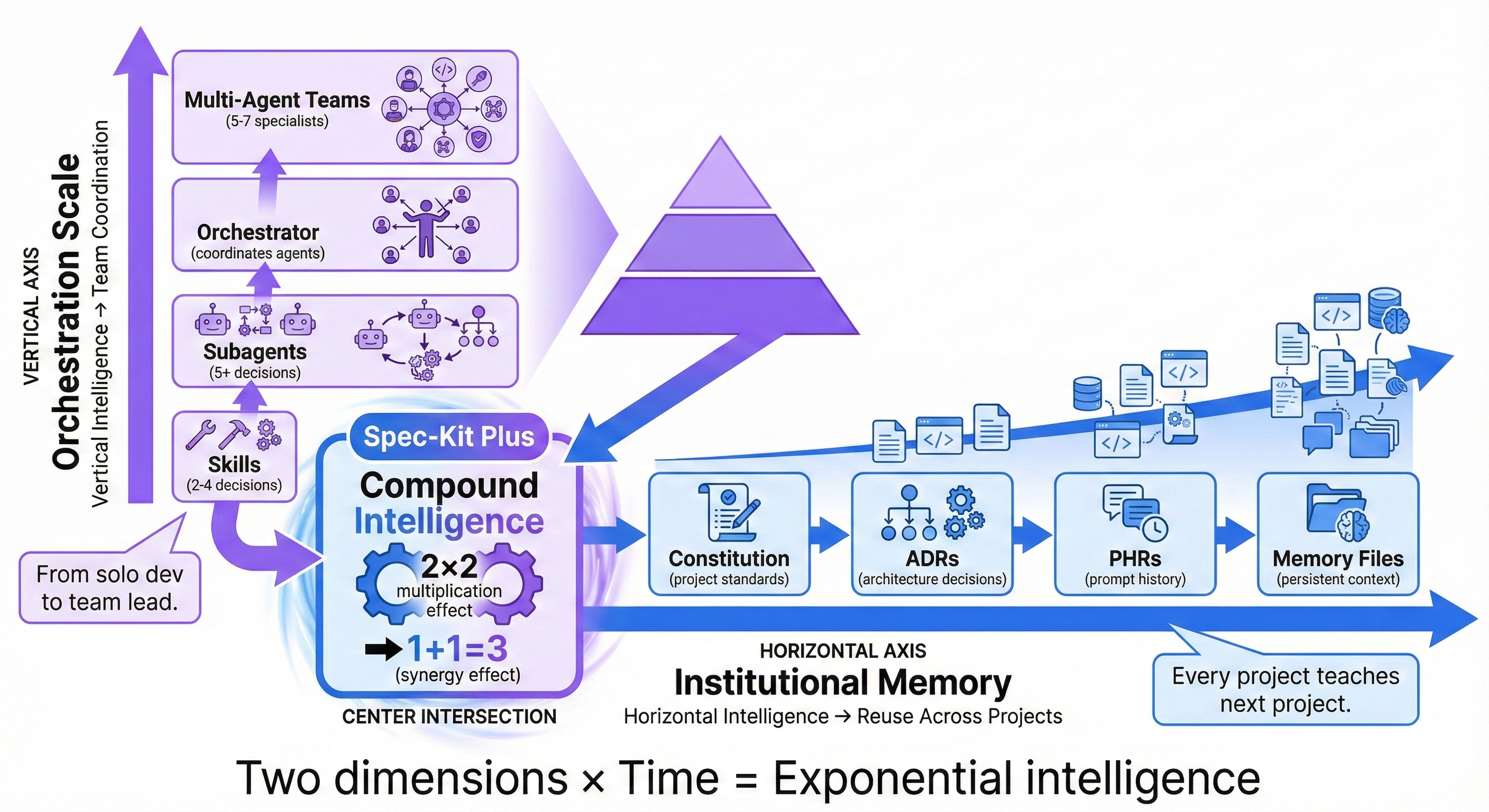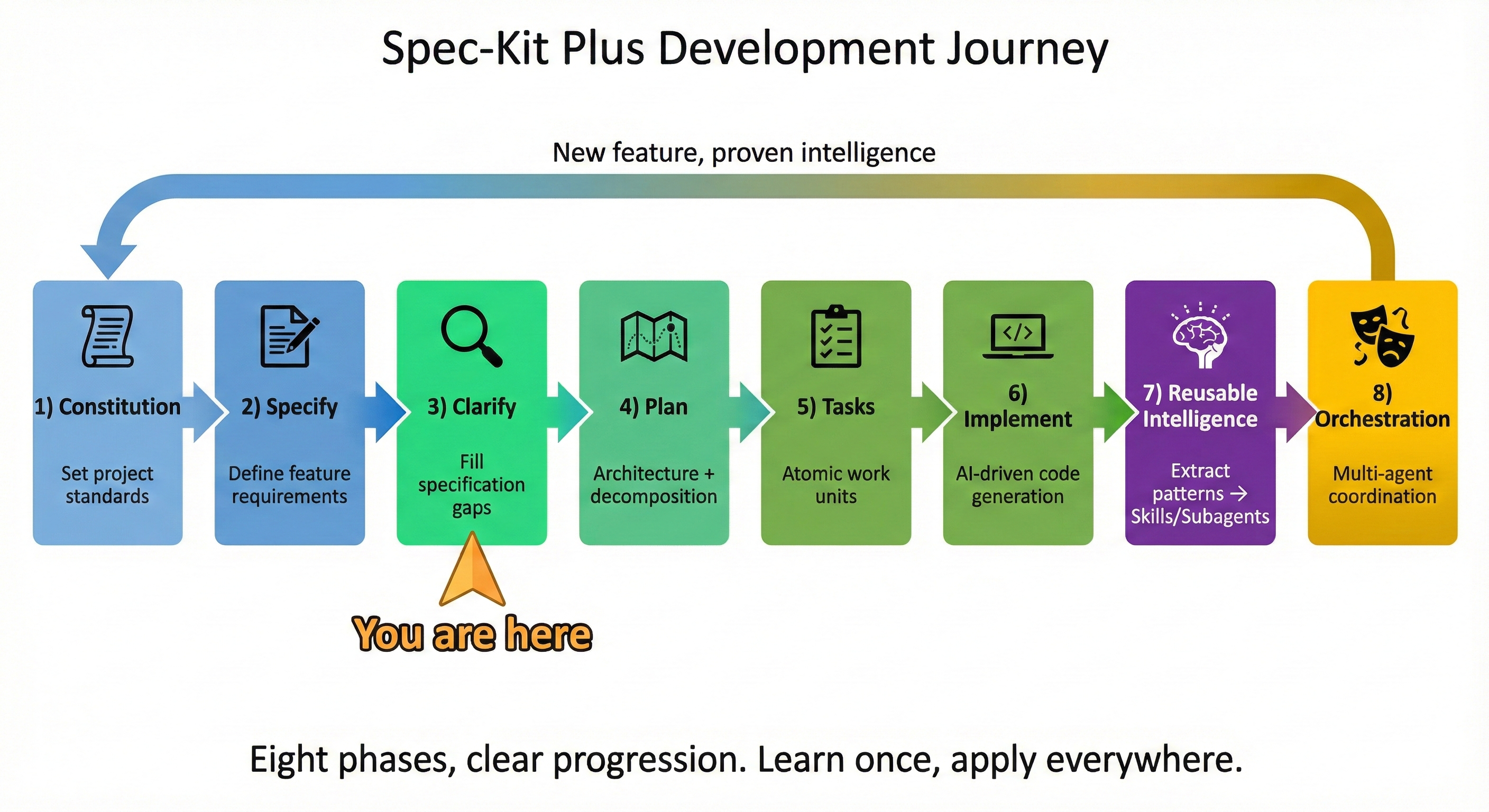Spec-Kit Plus Foundation: What You're About to Build With
Before installation, understand WHAT Spec-Kit Plus is and HOW it makes Reusable Intelligence practical.
By the end of this lesson, you'll understand how Spec-Kit Plus captures and reuses intelligence through its two-architecture pattern, and see exactly what intelligence artifacts you'll build in this chapter.
What Is Spec-Kit Plus?
Spec-Kit Plus is an SDD-RI framework built around one core idea: capture intelligence, not just deliver code.


Every feature you build generates two outputs:
- Working code (the deliverable - ephemeral, could be rewritten)
- Reusable intelligence (reasoning patterns, decision frameworks, AI prompts that work - permanent)
The framework provides:
- Templates for specifications, plans, ADRs (Architectural Decision Records), PHRs (Prompt History Records)
- Slash commands (
/sp.specify,/sp.plan,/sp.implement) that orchestrate AI subagents - Directory structure that separates ephemeral code from permanent intelligence
Critical distinction: Spec-Kit Plus is NOT an AI service. It's a methodology framework that works WITH your AI tool (Claude Code, Gemini CLI, etc.).
Horizontal Intelligence: Capturing Reasoning Across Time
Horizontal Intelligence is how Spec-Kit Plus turns decisions into reusable knowledge that persists across projects.
ADRs (Architectural Decision Records)
Document the "WHY" behind significant decisions, not just the "WHAT" you built.
Example:
- Bad documentation: "Used JWT for authentication"
- ADR (Horizontal Intelligence): "Chose JWT over sessions because: (1) microservices need stateless auth, (2) mobile clients benefit from token refresh, (3) tradeoff accepted: token revocation complexity"
When you create ADRs:
- During Constitution phase (Lesson 3) - Document project quality standards
- During Planning phase (Lesson 6) - Explain architectural choices
- When designing skills/subagents (Lesson 9) - Justify pattern selection
Storage: history/adr/ directory becomes your team's knowledge base
Reusability: Six months later, new team member asks "Why this approach?" → ADR answers immediately. AI agents READ ADRs to understand project context before generating code.
PHRs (Prompt History Records)
Automatically log AI collaboration sessions, capturing what prompts work vs what fails.
Example:
- Prompt A: "Write a calculator" → Generated insecure code (eval() vulnerability)
- Prompt B: "Write a calculator using safe math operations, no eval()" → Generated clean code
- PHR captures: Prompt B works, Prompt A fails, reasoning logged
When PHRs are created:
- Automatically during
/sp.specify,/sp.plan,/sp.implementexecution - You don't manually invoke PHRs - the system creates them
Storage: history/prompts/<feature>/ directory
Reusability: Project 2 starts with Project 1's PHRs. Your AI reads: "Last time, prompts emphasizing security constraints worked better than vague prompts." Project 2 specifications are immediately better.
What Makes This "Intelligence"
This isn't documentation for humans only:
- AI agents read ADRs to understand project context before reasoning
- AI agents learn from PHRs to avoid repeating past mistakes
- Intelligence accumulates - Project 10 is dramatically faster than Project 1
The compounding effect:
- Project 1: Create 3 ADRs + 10 PHRs (learning from scratch)
- Project 2: Start with 3 ADRs + 10 PHRs, create 3 new ADRs + 8 new PHRs (total: 6 ADRs, 18 PHRs)
- Project 10: Start with accumulated intelligence from 9 projects, rarely repeat mistakes
Vertical Intelligence: Delegation Through Specialization
Vertical Intelligence is how Spec-Kit Plus distributes work to specialized AI subagents, each designed with the Persona+Questions+Principles (P+Q+P) pattern.
The Delegation Pattern
YOU: "Build a calculator with 5 operations"
↓
ORCHESTRATOR: Routes to Specification Subagent
↓
SPEC SUBAGENT: Asks clarifying questions, generates complete spec
↓
YOU: Review and approve
↓
ORCHESTRATOR: Routes to Planning Subagent
↓
(Cycle repeats through Plan → Tasks → Implement)
What Makes Subagents "Intelligent"
Each subagent is designed with three components that activate reasoning (not just prediction):
1. Persona - Cognitive stance defining how to think
- Example: "You are a requirements analyst who obsesses over edge cases before implementation"
- Not generic: "You are a helpful assistant"
2. Questions - Analytical framework guiding reasoning
- Example: "What inputs can break this? What assumptions are hidden? What's the simplest test?"
- Not vague: "Is this good?"
3. Principles - Decision criteria for evaluating options
- Example: "Every data input must document boundary conditions (zero, negative, overflow)"
- Not arbitrary: "Make it good"
Example: Specification Subagent
Persona: Requirements analyst who thinks about edge cases before implementation
Questions:
- What happens when user inputs zero? Negative numbers? Strings instead of numbers?
- What assumptions am I making about input validation?
- What's the simplest test that proves this specification is complete?
Principles:
- SMART criteria enforcement (Specific, Measurable, Achievable, Relevant, Testable)
- Every data input has documented boundary conditions
- Every operation has at least 3 test cases (normal, edge, error)
Result: The Specification Subagent doesn't just generate output - it reasons through problems using expertise patterns.
What Makes This "Reusable Intelligence"
- Not calculator-specific: The Specification Subagent works for ANY feature needing a spec (authentication, payment processing, file uploads)
- Not rebuilt every project: You don't re-teach "how to write specs" - the subagent embeds that expertise
- Composable: Lesson 9 teaches you to CREATE your own subagents using the P+Q+P pattern, adding them to your intelligence library
Why "Vertical": Intelligence flows down a hierarchy (You → Orchestrator → Specialists), unlike Horizontal Intelligence which flows across time.
Try With AI
Ready to understand how Spec-Kit Plus turns project work into reusable intelligence? Explore these patterns:
🔍 Explore Intelligence Patterns:
"Compare Horizontal Intelligence (ADRs/PHRs) vs Vertical Intelligence (Subagents) in Spec-Kit Plus. Show me a concrete example: if I build a calculator in Project 1 and create 3 ADRs and 10 PHRs, how exactly does that intelligence help me when I build an authentication system in Project 2?"
🎯 Practice P+Q+P Analysis:
"I want to create a subagent for API design review. Help me design it using Persona+Questions+Principles (P+Q+P). What persona should it adopt? What questions should it ask to activate reasoning? What principles should guide its decisions? Show me why this approach works better than a generic prompt."
🧪 Test Compounding Understanding:
"Calculate the compounding effect: If Project 1 creates 5 ADRs + 12 PHRs, Project 2 creates 4 ADRs + 9 PHRs, and Project 3 creates 3 ADRs + 7 PHRs, how much intelligence is available when I start Project 4? Explain why intelligence accumulation makes later projects faster."
🚀 Apply to Your Domain:
"I work in [describe your domain/industry]. Help me design an intelligence architecture using Spec-Kit Plus. What Horizontal Intelligence should I capture (what decisions repeat across projects)? What Vertical Intelligence should I create (what specialized subagents would help)? Outline 3-5 intelligence artifacts I should build first."